
The time to set up your brooder? Well before you walk into the local feed store and hear peeping, or drool over the latest hatchery catalog. Give yourself time to do it right.
If you go the mother nature route and plan on one of your mama hens doing all the work, it still may be a good idea to have a brooder ready. Just in case. An unforeseen situation could crop up, where mama or the babies (or both) need a safe place.
Like chicken raising in general brooder techniques vary. I’ve seen and heard a myriad of methods. From top of the line store/ catalog bought equipment, to a cardboard box placed next to a woodstove. Income, breed, and quantity of chicks, climate, season, and available space will be factors in what type of brooder you use.
Some chicks arrive by mail and get picked up at the post office, others take that (hopefully) short drive from the grain store, local farm, etc.…. Others end up in a brooder due to a home hatching (either incubator or being removed from mother hen).
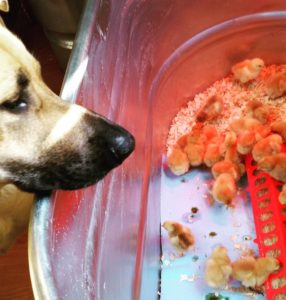
When raising poultry, everyone’s budget, time, space, and skill level differs. The intended purpose of the chicks differs as well (meat birds or egg layers?). Despite the many differences, we have this in common when placing chicks in a brooder:
We are assuming the role of mother hen We are nurturing chicks through the shaky first few days of life, and providing a solid base to become the healthiest chicken possible. We are the one who will now provide appropriate shelter, ample food, clean water, hygienic surroundings, and a safe environment to grow.
What is a brooder? A structure for rearing chicks or other birds. It can be handmade or store-bought.
A brooder is intended to house chicks until they are fully feathered. It is a man-made nest. Before being fully feathered, they are not capable of regulating body temperature, or even remotely capable of defending themselves. Broiler (meat) chicks may begin to feather sooner than heritage chicks, but in general, expect to keep your chicks in the brooder 4-6 weeks, depending on climate, season, type of chick, etc.
So, basically, after you place your babies in the brooder, you have a month or so to get the next step of housing ready for them. A brooder is intended to be their newborn nursery.

Brooder features
The Structure Itself
They sell brooders, or you can make one. People turn plastic bins, apple crates, and other items into brooders. Due to costs, not everyone has the same options. When deciding what home brooder keep these points in mind:
No pointy or sharp objects inside that chicks could get hurt on (nails, screws…). You need to be able to sanitize it. It needs to be sturdy, and not prone to move or tip easily. It needs to withstand hot bulbs (if you use bulbs). It needs to fit the space allotted for it. And in my book, it needs to be reusable (cost-effectiveness). It needs to be predator-proof.
Metal stock tanks and tubs are easy to clean, built to last, and reusable in many other ways. They are great retainers of heat. They can be disinfected.
Wooden brooders can be built from (safe for animals) re-salvaged wood, your own cut lumber, or even wooden crates. Since wood is porous, they absorb liquid and are harder to sanitize.
Plastic tubs are popular, but be aware that they are lighter than other options. Humans and even dogs can bang into them, and easily knock them over. Same with those small plastic fence corrals. One bump from a large dog, or a curious cat, and there it goes.
Research the many types of brooders to see what will work best for you.

A stock tank brooder with a handmade adjustable light stand, and mesh cover
Space requirements per bird
Chicks only need approximately 6 inches of space per bird for the 1st two weeks, then it increases to approximately 12 inches per chick. The older they get, the more space they need.
You want to avoid overcrowding. Overcrowding can cause health issues, overheating, and smothering. Chicks grow very fast. Depending on breed, and quantity of chicks, you may need more than one brooder. Or stagger batches of chicks over a period of time.
A small flock of six can stay in the brooder longer than a huge batch of chicks.
Temperature/lighting
The temperature of a room may be very different than the temperature inside the brooder.
A thermometer is handy to monitor the temperature inside a brooder. Some are hung while others are mounted to an inside wall. Chicks will peck at them at some point, so make sure they are safe for use in brooders.
Clip-on, or hanging lamps (using regular light bulbs or heat bulbs), adjustable height ‘Eco glow’ warmer lights, and good old fashion sunlight are some methods used to provide light and warmth. Hanging lights need to be approximately 16- 18 inches above chicks in the beginning.
Lights need to be above the brooder, in a manner that allows you to raise and lower it. Mounting one on an adjustable stand next to the brooder can make this easier. Make sure any light is totally secure, so it cannot be accidentally knocked over, or possibly fall into the brooder. Watch your head (and hair!) around hot lights.
The Eco glow type heaters are like little bridges. Chicks can come and go under the light at will.
Bright lights or too much heat can cause chicks to get overstimulated, or aggressive. If they start pecking each other incessantly, look at your crowding level, lighting, and temps. Red light, whether by a heat lamp or red bulb, is more soothing than a bright white light.
The suggested temperature for the 1st week is 95 degrees Fahrenheit/35 degrees Celsius. It needs to be lowered by 5 degrees each week until the chicks leave the brooder. How do you lower the temperature? Move the light further away from the chicks each week, and regulating the room temperature if possible.
The chicks need to be able to get away from the heat source. Arrange your brooder on one end of the structure, so the lights’ arc does not shine on the entire area. This creates a cooler and warmer side. In the beginning, most will stay right under the light, on the warmer side. As they grow, some may prefer the cooler side of the brooder, away from direct heat/light.
If you ever wonder if they are comfortable, observe them. The chicks will let you know when they’re chilly by really huddling or piling on top of each other. When warm, they spread out, and visibly look relaxed during rest time.
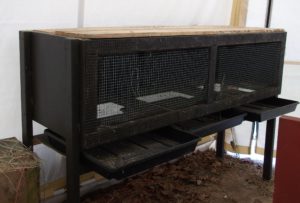
One of our homemade wooden brooders.
Safety
Put a cover on the brooder. Chicks fly out and get hurt. People drop things in brooders by accident. Family pets or youngsters can mess with chicks when you don’t want them to. Stuff happens.
Sturdy steel mesh that form fits to the top of metal stock tanks can work. Wooden planks, wooden top doors (with latches to close them) works well on wooden structures.
Open brooders can work in a non-busy, pet, and child-free environment. Otherwise, cover the brooder.
Pets and children should not be allowed to touch chicks without supervision.
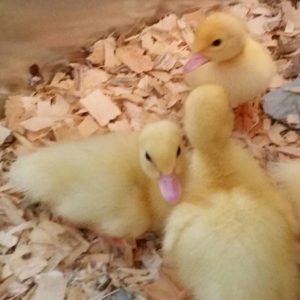
Muscovy ducklings
Bedding
If you have a solid floor brooder, it needs to be level. It needs to have a couple of inches of shavings (or whatever chick -safe absorbent material you choose). Chicks can develop leg issues on uneven flooring. If you have a screen floor, use a small enough gauge, so their tiny chick legs do not get stuck, but most of the feces can fall through.

‘Poop goes through screen floor.’ Cornish cross broiler chicks
Handling chicks
When handling baby poultry, wash hands before and after. This protects you, and the chicks from passing bacteria. Make sure the person holding them is low to the floor (sitting on the floor is best) in case they drop them. If you have a door to the room they are housed in: shut it, in case one gets loose, or an unwanted pet runs in. Pets and children should not be introduced to chicks without adult supervision.
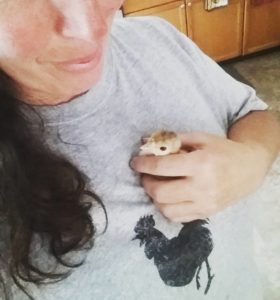
Bourbon Red heritage turkey poult
Water
It is recommended to dip each chick’s beak in their water container as you place them in the brooder. This lets them know where it is. Use waterers meant for chicks. Adult waterers or dog water bowls are not safe until they are older. Many people add sugar, electrolytes, or vitamin supplements to chick water.
Be prepared to change water many times a day. Food from the chicks’ beaks messes it up, as does poop.
You will also be unclogging waterer rims if you use shavings, as shavings will make their way in there. You can limit the shavings issue by raising them up a bit with a non- toxic item placed beneath, making sure the waterer isn’t too wobbly.
Food
Like water, introduce chicks to their food as soon as you place them in the brooder. Use food intended for chicks, and in a small crumble size. If the food is too large, they will not be able to eat it. If it is lacking in the necessary nutrients, they will not grow properly. Research the many types of chick feed (homemade or store-bought), to decide what is best for you.
Thanks to studies done for broiler chicken growers, poultry feed and water manufactures know that red attracts very young chicks. This explains why you see so many red feeders in stores. If you have sluggish eaters, maybe use a red feeder, or introduce red around the feeder and see what happens.

Curious chicks
Hygiene
Keep the brooder clean and dry. Chicks poop a lot. Water containers get knocked over. A wet brooder is a host of harmful bacteria, which can lead to disease and infection.
Clean waterers and feeders with hot soapy water on a regular basis. Chicks roost on anything, and their poop gets everywhere.
Replace all shavings as needed, instead of just adding a layer on top of soiled shavings. If you have a screen floor brooder, empty the poop trays as often as possible. This may mean more than once a day.
Have a plan in place for the disposal of fecal matter and shavings.
While on the hygiene subject, I found that having a box or second holding area for chicks helpful when cleaning. Reaching in to clean around chicks isn’t that hard in the beginning, but as they get bigger, some of them freak out. Placing them in a cage or box will let you really get in the brooder and clean it thoroughly.
Ease of use for humans
Chicks need lots of care. You will be feeding, watering, and cleaning frequently, and checking on them quite a bit. A brooder that is too low, or too high will be uncomfortable to work with. When you pick up one chick, you don’t want all the other jumping or flying out. Take that into consideration when choosing a design.
Keep cleaning supplies, trash bags, trash barrels, brooms, extra waterers, food — anything else you use frequently — near the brooder. This saves a lot of time during clean up.
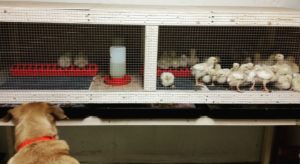
Growing Up
For the 1st two weeks: if they have the proper surroundings, ample food, and water-chicks are pretty much content eating, sleeping, and pooping.
As they get older, they get more active and curious. Small boxes they can hide in, sticks to hop on, and other safe items to perch on can give them something to do.
Some time with the first six weeks, chicks will start erupting pin feathers. They sometimes start chewing on these, causing them to bleed. This blood attracts their brooder mates, sometimes causing a bigger pecking problem. Having a no-pick salve or powder on hand (you apply it to the bloody feathers) will help you through this period.
A change of scenery does wonder for bored chicks. Once feathered, on warm sunny days, I bring mine outside. They spend a couple of hours at a time in chick safe tractors to peck the grass and dirt, or larger stand up brooders (with screen fronts) to get some natural sunlight, and safely watch all the activity on the homestead.
Please be cautious when moving chicks from one place to another. Pet carriers or small rabbit cages work great for this. Too many chicks escape if just hand carried.
Raising chicks is work, but if you love spending time with peeping little balls of fluff, it’s fun work. You are given this opportunity to act as the mother hen, something not everyone does. Enjoy it!












